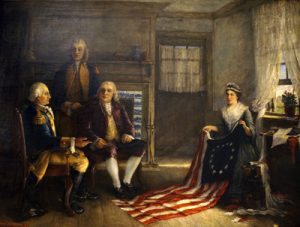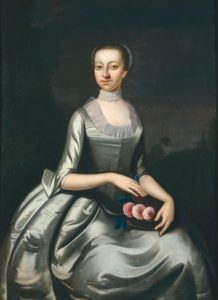Both “Revolutionary Bodies: Women and the Fertility Transition in the Mid- Atlantic Region” and “How Betsy Ross became Famous” pulls primary evidence from portraits painted by male artists. These men both provide examples to support the cultural shift of women’s perceived sexuality and profit off the imagery and mythology behind significant women in U.S history.
“Revolutionary Bodies” dictates that the style of painting women’s portraits when analyzed reflects their abilities to produce heirs. Frequently women are showed sitting with their legs apart (covered by a dress of course) with either flowers or fruit. This visualization of flowers or fruit at crotch level draws the eyes there and acts as a kind of advertisement that this woman is ready and willing to produce children. Elizabeth Peel by Benjamin West is a prime example of this trend painted in 1751. Elizabeth is shown in the typical pose; legs spread apart, flowers siting on her crotch but this painting quite literally has leaves pointing at her crotch. As well her hands are shaped to make it appear the she already has a rounded belly. The paintings included in this article, that show these characteristic poses were painted by men. Which is a confounding issue because this only portrays men’s portrayals of women not how women view themselves or their own sexuality which would be a vital component for a women’s history class.
How Betsy Ross became famous also struggles with the theme of men profiting of their own portrayals of women figures. Charles H. Weisgerber took the image of Betsy and made her into an enterprise. Beginning with his painting of her called The Birth of our Nation’s flag (1892) which was seen by millions of people at the Chicago’s world fair. Weisgerber created this imagery of a domestic woman doing her part to support the revolution. The idea of a woman being patriotic while still being domestic was a significant idea at a time in which women’s rights were viewed as a radical endeavor. Betsy became an ideal for the place of women with the American society. Not only did Weisberger impose his own idea of the domestic patriotism upon Betsy Ross but he profited off of her name. He started a movement to renovate the home thought to be Betsy’s then moved his family into it. He Was a charter member of the American flag house as well as the Betsy Ross Memorial association. His own promotion of Betsy Ross appears to be much less a desire to increase awareness as it is a business venture. The more popular he makes Betsy Ross the more valuable both his painting and business will be, as he partly supported himself by selling souvenirs.
“Revolutionary Bodies: Women and the Fertility Transition in the Mid- Atlantic Region” and “How Betsy Ross became Famous” share an unfortunate similarity in in both cases men use their own influence to control the way women are viewed to both historical and modern societies. With women subjugated for so long it is not a surprise that we do not have more paintings by women artists. Better known art is more likely to be preserved. Therefore, we as viewers should be aware of such biases and interpret accordingly.
Images
West, Benjamin. “Elizabeth Peel.” PAFA, 2007, Pennsylvania Academy of the Fine Arts, Philadelphia PA, www.pafa.org/collection/elizabeth-peel.
Weisgerber, Charles. “Birth of Our Nation’s Flag.” Library of Congress, 1893, Library of Congress, www.loc.gov/pictures/item/2004669130/.


